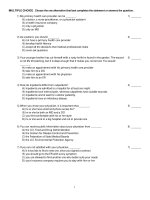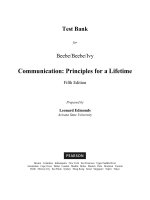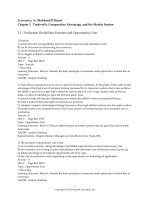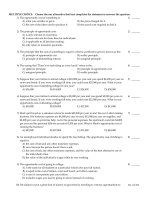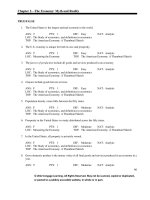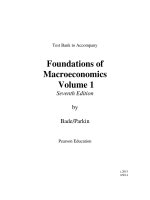Principles of economics 5th edition frank test bank
Bạn đang xem bản rút gọn của tài liệu. Xem và tải ngay bản đầy đủ của tài liệu tại đây (1.35 MB, 188 trang )
Chapter 02
Comparative Advantage
Multiple Choice Questions
1.
To say that an individual possesses an absolute advantage in the production of software means that
individual:
A. has a lower opportunity cost of producing software.
B. can produce more and/or higher quality software in a given amount of time.
C. was the first to create the software.
D. charges the lowest price for software.
2.
If Scout has an absolute advantage over Dill:
A. Scout has more money than Dill.
B. the problem of scarcity applies to Dill, but not to Scout.
C. the problem of scarcity applies to Scout, but not to Dill.
D. Scout can accomplish more in a given period of time than can Dill.
3.
If Leslie can produce two pairs of pants in an hour while Eva can make one pair an hour, then it
must be the case that:
A. Leslie has a comparative advantage.
B. Leslie has an absolute advantage.
C. Eva has a comparative advantage.
D. Leslie has both comparative and absolute advantage.
4.
If a nation can produce a good more quickly than any other nation, that nation has a(n):
A. comparative advantage.
B. absolute advantage.
C. relative advantage.
D. specialization advantage.
5.
Having a comparative advantage in a particular task means that:
A. you are better at it than other people.
B. you give up more to accomplish that task than do others.
C. you give up less to accomplish that task than do others.
D. you have specialized in that task, while others have not.
6.
Larry has a comparative advantage in writing a term paper if he:
A. can write a paper faster than the other students in class.
B. has an absolute advantage in writing a term paper.
C. always earns an A on his papers.
D. has the lowest opportunity cost for writing a term paper.
7.
If a nation has the lowest opportunity cost of producing a good, that nation has a(n):
A. comparative advantage.
B. absolute advantage.
C. comparative advantage and an absolute advantage.
D. absolute advantage and possibly a comparative advantage.
8.
Which of the following statements is always true?
A. Absolute advantage implies comparative advantage.
B. Comparative advantage does not require absolute advantage.
C. Absolute advantage requires comparative advantage.
D. Comparative advantage requires absolute advantage.
9.
If Jane can produce 3 pairs of shoes hourly, while Bob can produce 2, then one can infer that the
__________ advantage belongs to __________.
A. absolute; Jane
B. comparative; Jane
C. comparative; Bob
D. comparative and absolute; Jane
10.
Refer to the table above. According to the data, Corey has an absolute advantage in:
A. the production of pizza.
B. neither the production of pizza nor the delivery of pizza.
C. delivering pizza.
D. both the production of pizza and the delivery of pizza.
11.
Refer to the table above. According to the data, Pat has an absolute advantage in:
A. the production of pizza.
B. neither the production of pizza nor the delivery of pizza.
C. delivering pizza.
D. both the production of pizza and the delivery of pizza.
12.
Refer to the table above. Corey's opportunity cost of the production of an extra pizza is the delivery
of ______ pizza(s).
A. 2
B. 3/2
C. 2/3
D. 1/2
13.
Refer to the table above. Corey's opportunity cost of the delivery of an extra pizza is the production
of ______ pizza(s).
A. 6
B. 12
C. 2
D. 1/2
14.
Refer to the table above. Pat's opportunity cost of the production of an extra pizza is the delivery of
______ pizza(s).
A. 3
B. 2
C. 3/2
D. 2/3
15.
Refer to the table above. Pat's opportunity cost of the delivery of an extra pizza is the production of
_____ pizza(s).
A. 12
B. 10
C. 3/2
D. 2/3
16.
Refer to the table above. The comparative advantage for pizza production belongs to __________
and the comparative advantage for pizza delivery belongs to __________.
A. Corey; Corey
B. Pat; Pat
C. Pat; Corey
D. Corey; Pat
17.
Refer to the table above. Based on their comparative advantages, Pat should specialize in _______
while Corey should specialize in _______.
A. pizza delivery; pizza production
B. pizza production; pizza delivery
C. neither pizza production nor pizza delivery; both pizza production and pizza delivery
D. both pizza production and pizza delivery; neither pizza production nor pizza delivery
18. Which of the following is true?
A. Lou has both an absolute advantage and a comparative advantage over Alex in both tasks.
B. Alex has a comparative advantage over Lou in cleaning.
C. Lou has a comparative advantage over Alex in cleaning.
D. Lou has a comparative advantage over Alex in cooking.
19. Lou and Alex live together and share household chores. They like to cook some meals ahead of
time and eat leftovers. Suppose that in one hour Lou and Alex can do the following:
Alex and Lou have worked out an efficient arrangement. Under that arrangement:
A. Alex and Lou do half of the cooking and half of the cleaning.
B. Alex does all of the cleaning, while Lou does all the cooking.
C. Lou does all of the cleaning and half of the cooking.
D. Lou does all of the cleaning, while Alex does all of the cooking.
20. Lou and Alex live together and share household chores. They like to cook some meals ahead of
time and eat leftovers. Suppose that in one hour Lou and Alex can do the following:
For Alex, the opportunity cost of cleaning one room is ____ meal(s); for Lou the opportunity cost of
cleaning one room is _____ meal(s).
A. 4; 4
B. 1; 4/5
C. 1; 5/4
D. 3; 5
21. Dent ‘n' Scratch Used Cars and Trucks employs 3 salesmen. Data for their sales last month are
shown in this table:
________ has an absolute advantage in selling cars and __________ has an absolute advantage in
selling trucks.
A. Joe; Joe
B. Larry; Ralph
C. Ralph; Larry
D. Larry; Joe
22. Dent ‘n' Scratch Used Cars and Trucks employs 3 salesmen. Data for their sales last month are
shown in this table:
For Larry, the opportunity cost of selling a truck is:
A. 10 fewer cars sold.
B. 1/2 car not sold.
C. 1 fewer car sold.
D. 2 fewer cars sold.
23. Dent ‘n' Scratch Used Cars and Trucks employs 3 salesmen. Data for their sales last month are
shown in this table:
For Joe, the opportunity cost of selling a truck is:
A. 9 fewer cars sold.
B. 1 fewer cars sold.
C. 4 fewer cars sold.
D. 1/3 car not sold.
24. Dent ‘n' Scratch Used Cars and Trucks employs 3 salesmen. Data for their sales last month are
shown in this table:
For Ralph, the opportunity cost of selling a truck is:
A. 9 fewer cars sold.
B. 1/3 car not sold.
C. 3 fewer cars sold.
D. 1/4 car not sold.
25. Dent ‘n' Scratch Used Cars and Trucks employs 3 salesmen. Data for their sales last month are
shown in this table:
Joe's opportunity cost of selling a car is ______ than Ralph's, and Joe's opportunity cost of selling a
car is ______ than Larry's.
A. less; greater
B. greater; less
C. less; less
D. greater; greater
26. Dent ‘n' Scratch Used Cars and Trucks employs 3 salesmen. Data for their sales last month are
shown in this table:
______ should specialize in truck sales, and ______ should specialize in car sales.
A. Joe; Ralph
B. Ralph; Larry
C. Larry; Ralph
D. Larry; Joe
27. Application of the Principle of Comparative Advantage leads to:
A. greater specialization of labor and other factors of production.
B. less specialization of labor and other factors of production.
C. societies without any specialization of labor.
D. lower total output.
28. The textbook notes that the last time a major league batter hit .400 was in 1941. This is because:
A. the average quality of batters has fallen.
B. the league imposes harsh penalties for steroid use.
C. specialization by pitchers, infielders, and outfielders has made it harder for batters to hit.
D. baseball diamonds have become larger.
29. Ginger and Maryann are lost in the jungle, where the only things to eat are mangoes and fish.
Ginger can gather mangoes faster than Maryann and can also catch more fish per hour than can
Maryann. Therefore:
A. Ginger should specialize in fishing because it is harder than gathering mangoes, and Maryann
should specialize in gathering mangoes.
B. Ginger should strike out on her own, because Maryann reduces their combined productivity.
C. Maryann should specialize in the activity for which she has a comparative advantage.
D. Ginger should specialize in the activity for which she has an absolute advantage.
30. In general, individuals and nations should specialize in producing those goods for which they have
a(n):
A. absolute advantage.
B. comparative advantage.
C. absolutely comparative advantage.
D. absolute advantage and a comparative advantage.
31. In general, individuals and nations should specialize in producing goods _________ other individuals
or nations.
A. that they can produce more quickly than
B. that they can produce less quickly than
C. for which they have a lower opportunity cost compared to
D. for which they have a higher opportunity cost compared to
32. A country may have a comparative advantage in the production of cars if:
A. it imports most of the raw materials necessary to produce cars.
B. its citizens prefer driving cars to other forms of transportation.
C. it has strict environmental protection laws governing automobile emissions.
D. it has the natural resources needed to produce steel.
33. The United States generally has a comparative advantage in the development of technology
because of:
A. larger amounts of natural resources.
B. a high concentration of the best research universities.
C. tax incentives.
D. the existence of patent law, which no other country provides.
34. The United States has a comparative advantage in producing books and movies because:
A. New York and Hollywood are the historic centers of book publishing and movie production.
B. wages for workers who print books and make movies are lower in the United States than
elsewhere.
C. the English language is understood by many people all over the world.
D. the United States gives generous tax breaks to publishers and movie producers.
35. The United States was unable to maintain its dominance in the production of televisions because:
A. the highly technical skills necessary to produce televisions are greater in other countries.
B. the raw materials necessary to build televisions became scarce in the United States.
C. the product designs evolved too rapidly for United States engineers to keep up.
D. automated production allowed production to be outsourced to countries with less-skilled
workers.
36. A graph that illustrates the maximum amount of one good that can be produced for every possible
level of production of the other good is called a(n):
A. production possibilities curve.
B. consumption possibilities curve.
C. production function.
D. supply curve.
37. The production possibilities curve shows:
A. the minimum production of one good for every possible production level of the other good.
B. how increasing the inputs used for one good increases the production of the other good.
C. the maximum production of one good for every possible production level of the other good.
D. how increasing the production of one good allows production of the other good to also rise.
38. The production possibilities curve is:
A. the boundary that divides all production combinations into efficient and inefficient ones.
B. a graph illustrating the production combinations society would like to choose.
C. the boundary that divides all production combinations into attainable ones and unattainable
ones.
D. a graph illustrating supply curves for different combinations of output.
39. The core principle that is illustrated by the production possibilities curve is:
A. the Scarcity Principle.
B. the Cost-Benefit Principle.
C. the Incentive Principle.
D. The Principle of Comparative Advantage.
40. This graph describes the production possibilities on the island of Genovia:
The opportunity cost of producing one car in Genovia is:
A. 5,000 tons of agricultural products.
B. 500 tons of agricultural products.
C. 5 tons of agricultural products.
D. 50 tons of agricultural products.
41. This graph describes the production possibilities on the island of Genovia:
The opportunity cost of producing one ton of agricultural products in Genovia is:
A. 1,000 cars.
B. 1 car.
C. 1/5 of a car.
D. 1/50 of a car.
42. This graph describes the production possibilities on the island of Genovia:
Assuming efficient production, If 500 cars are produced in Genovia:
A. 50,000 tons of agricultural products are also being produced.
B. 25,000 tons of agricultural products are also being produced.
C. 45,000 tons of agricultural products are also being produced.
D. 40,000 tons of agricultural products are also being produced.
43. The slope of the production possibilities curve must be:
A. positive.
B. decreasing.
C. increasing.
D. negative.
44. The slope of any production possibilities curve is __________ because __________.
A. negative; more production of one good means less production of the other
B. constant; the tradeoff in production never changes
C. positive; more production of one good means more production of the other
D. positive; more production of one good means less production of the other
45.
Refer to the figure above. Becky's maximum production of clogs per hour is represented by point:
A. u.
B. t.
C. v.
D. w.
46.
Refer to the figure above. Becky's maximum production of sandals per hour is represented by
point:
A. u.
B. t.
C. v.
D. z.
47.
Refer to the figure above. Point u is an __________ point in relation to the production possibilities
curve.
A. attainable
B. efficient
C. unattainable
D. inefficient
48.
Refer to the figure above. Of the labeled points, ______________ are attainable.
A. only t and u
B. only x, y, and z
C. only w, x, y, z, and v
D. only w, x, y, z, v, and t
49.
Refer to the figure above. Of the labeled points, ______________ are efficient.
A. only t and u
B. only x, y, and z
C. only w, x, y, z, and v
D. only w, x, y, z, v, and t
50.
Refer to the figure above. Point t is an __________ point in relation to the production possibilities
curve.
A. attainable
B. efficient
C. unattainable
D. inefficient
51.
Refer to the figure above. Point y ___________________________ point v.
A. is more efficient than
B. is less efficient than
C. is equally as efficient as
D. is more attainable than
52.
Refer to the figure above. Relative to point x, at point y:
A. more sandals and more clogs are produced.
B. more sandals and fewer clogs are produced.
C. more clogs and fewer sandals are produced.
D. fewer sandals and fewer clogs are produced.
53.
Refer to the figure above. Suppose that during the summer Becky can sell more sandals than she
can clogs. If she had been producing at point x in the winter, during the summer she will produce
at:
A. point w.
B. point z.
C. point u.
D. point t.
54.
Refer to the figure above. For Pat, the opportunity cost of removing one bag of trash is:
A. not planting 25 bulbs.
B. not planting 5 bulbs.
C. not planting 10 bulbs.
D. not planting one-fifth of a bulb.
55.
Refer to the figure above. For Chris, the opportunity to removing one bag of trash is:
A. not planting 25 bulbs.
B. not planting 5 bulbs.
C. not planting 3 bulbs.
D. not planting one-third of a bulb.
56.
Refer to the figure above. If Pat and Chris were to specialize in the task for which each has a
comparative advantage:
A. Chris would plant bulbs and Pat would remove trash.
B. Chris would remove trash and Pat would plant bulbs.
C. Pat and Chris would each spend one hour on each task.
D. both Pat and Chris would plant bulbs because they both have an absolute advantage in that
task.


